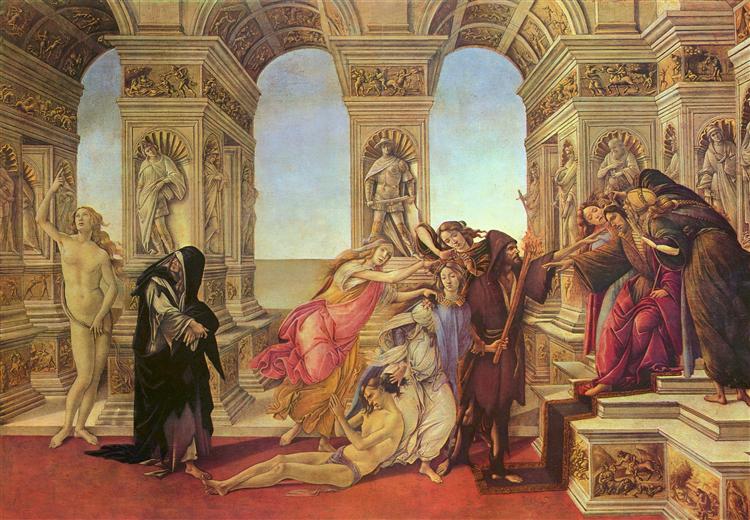Description
Sandro Botticelli's Calumny of Apelles, painted in 1495, stands out not only for its aesthetic beauty, but also for its rich symbolic charge and intricate visual narrative. Illustrating a theme that comes from classical antiquity, this painting reflects Botticelli's mastery in the use of form, color and the representation of the human figure in an allegorical context.
The composition of the work is remarkably complex. In the centre, a male figure is in the position of judgement, representing truth, while around him are the various allegories related to the concept of slander. Botticelli uses a triangular arrangement to guide the viewer's gaze through the scene, directing it from the central figure towards the characters surrounding the main narrative. On the left, a female figure symbolising Ignorance can be seen, with her pitiful attitude and a gesture that reveals the manipulation of information. On the right, the figure of Slander is presented in an aggressive and defiant manner, accompanied by Envy, which is insinuated in a shadowy space, which intensifies the drama of the scene.
Colour plays a pivotal role in creating mood and atmosphere. Botticelli, known for his rich, nuanced palette, uses warm and cool tones to establish emotional contrasts. The softness of the colours in the figures’ clothing emphasises both the fragility and complexity of truth and fallacy in the story’s telling. Subtle shades of blue and earth act in symmetry with the warmth of the background, creating a space that is simultaneously enveloping and emotionally charged.
In terms of iconography, “Calumny of Apelles” reveals Botticelli’s connection to classical texts, specifically the tale involving the Greek painter Apelles, who was the victim of falsehoods in his life. Botticelli’s ability to weave a complex narrative through mythical figures reflects his deep understanding of literary and philosophical tradition, as well as his fascination with human nature. This work, therefore, is set in a context that allows viewers to reflect on truth, lies, and the lived experience of human beings.
An aspect that often goes unnoticed is the presence of the architectural background, which suggests a utopian environment. This use of perspective and architecture brings an air of serenity to a scene that is, indeed, one of conflict. The columns represent stability, contrasting with the chaos of the human figures in the foreground and enriching the viewer's experience.
Attention to detail is another of Botticelli's hallmarks, visible in the meticulous execution of the drapery and facial expressions. Each figure is emblematic, designed to convey an emotional and psychological meaning that transcends simple representation. The interaction between the figures, both physically and emotionally, allows for a dialogue that invites the viewer to contemplate not only the work itself, but also the deeper implications of slander and judgment in everyday life.
"Calumny of Apelles" is not only a masterpiece of the Renaissance but also a testament to Botticelli's ability to fuse history, symbolism and aesthetics into a single image. This painting invites reflection not only on the narrative it depicts, but also on the relevance of its themes in the contemporary context, making it an eternal object of study in art history.
KUADROS ©, a famous painting on your wall.
Hand-made oil painting reproductions, with the quality of professional artists and the distinctive seal of KUADROS ©.
Painting reproduction service with satisfaction guarantee. If you are not completely satisfied with the replica of your painting, we will refund 100% of your money.

